Aponogeton angustifolius
Aponogeton angustifolius Aiton
Family: Aponogetonaceae
Common names: delicate Cape-pondweed, narrow-leaved Cape-pondweed (Eng.); delikate waterblommetjie, wateruintjie (Afr.)
Introduction
Aponogeton angustifolius is a freshwater aquatic, with small, ornamental floating leaves and delicate, short sprays of white flowers. It is becoming increasingly threatened in the wild. It is suited to seasonal garden ponds, or, grown in urns or bowls, it makes an interesting water plant for a sunny courtyard garden.
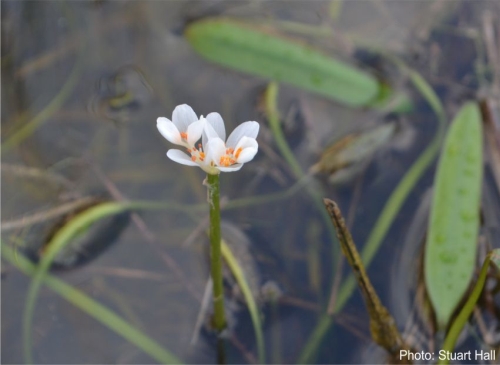
Description
Description
This winter-growing, summer-dormant plant is technically a hydrogeophyte (a plant with a subterranean storage organ that grows in water). It grows from a vertically-oriented, tuberous stem covered with dark brown, fibrous, outer tunics. The tuberous stem annually forms a new stem above a persistent string of flattened older ones, and the new roots grow from the top of the newest stem. The plant produces several small, lance-shaped or narrowly elliptical, light green, floating leaves that have a prominent midrib along the lower surface, and are produced at the tips of thin petioles.
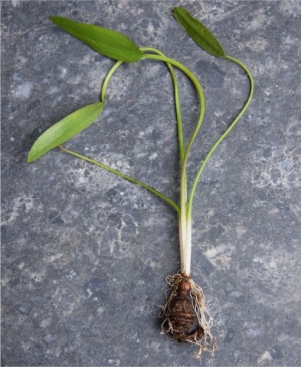
The inflorescence comprises a flimsy, green flower stem which appears above water level, and a short, forked spray of up to 10 stalkless, white, unscented flowers, each having 2, or rarely 3, boat-shaped tepals that are sometimes flushed pinkish-maroon towards the base. The flowers have 6 short stamens with white, erect filaments, deep brownish-maroon anthers and yellow or orange ripe pollen, and an erect, white style that rises slightly above the anthers. The ripe fruit consists of greenish, spongy follicles containing green, slender, spongy seeds about 10 mm long. The flowering period is from early winter to mid-spring (June to September).
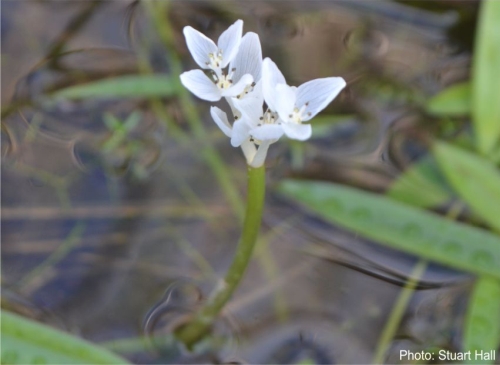
Conservation Status
Status
This species is considered to be Near Threatened (NT), because of the increasing loss and degradation of its habitat resulting from urban sprawl, especially on the Cape Peninsula, Cape Flats and around Stellenbosch, as well as water pollution from agricultural run-off and expanding crop cultivation in other areas of the Western Cape, according to the the SANBI Red List of South African Plants.
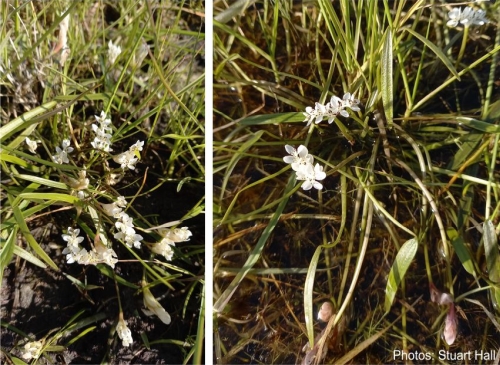
Distribution and habitat
Distribution description
Aponogeton angustifolius has a restricted distribution in the southwestern part of the Western Cape, occurring from Gouda and Malmesbury in the west to Worcester in the east, around Stellenbosch and on the Cape Flats, and in the southern Cape Peninsula including the suburbs of Wetton, Kenilworth and Ottery. It occurs in full sun in seasonal winter ponds and slow-flowing streams among water-loving grasses, and inhabits numerous vegetation types, including Peninsula Shale Renosterveld, Breede Shale Fynbos and Cape Flats Dune Strandveld. It is sometimes seen flowering together with the cormous aquatic Pauridia aquatica (Hypoxidaceae). The subterranean tuberous stem of A. angustifolius remains permanently embedded within soil of shallow, seasonal ponds, ditches and slow-flowing streams. Should the water level drop significantly, the plants continue to grow and flower, provided the soil remains moist enough in winter and spring.
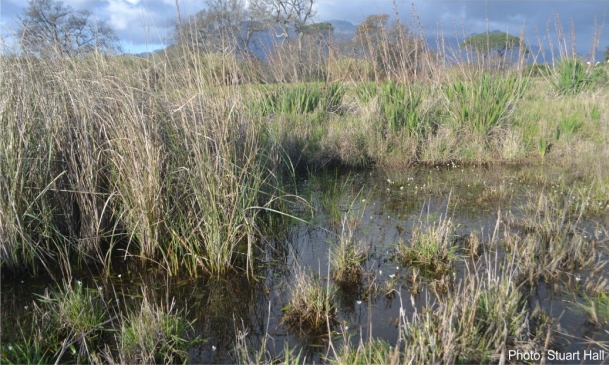
Derivation of name and historical aspects
History
The genus name Aponogeton is derived from the Celtic apon, meaning ‘water’, and the Greek geiton, meaning ‘neighbour’, with reference to its occurrence near or within water. The specific name angustifolius is Latin, referring to its narrow leaves.
Aponogeton angustifolius was introduced into cultivation in Britain by the Scottish plant collector Francis Masson in 1788, from plants he had collected at the Cape. It was described for the first time by the Scottish horticulturist and botanist William Aiton in 1789 in the first volume of Hortus Kewensis, a catalogue of plants cultivated in the Royal Botanic Gardens, Kew. An elegant watercolour and pencil illustration of the plant by Sydenham Edwards appeared on plate 1268 of Curtis’s Botanical Magazine in 1810.
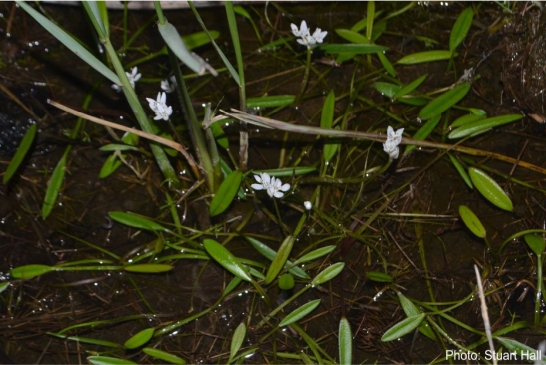
The Water Hawthorn family, Aponogetonaceae, is monogeneric, meaning that it contains a single genus, Aponogeton. Comprising over 40 species, it is widely distributed, occurring in Africa, Asia, Madagascar and Australia. In Africa it is entirely confined to the southernmost part, extending from coastal parts of the southern Cape to Zimbabwe in southern Tropical Africa, and there are nine species in South Africa. Apart from its substantially larger leaves and tepals, and more numerous stamens, the very well-known A. distachyos (of waterblommetjie bredie (stew) fame) differs from A. angustifolius in having flowers with a single tepal, and a distinct ‘hawthorn’ or almond-like scent. A. distachyos has become widely naturalized abroad in temperate parts, including southeast Australia, New Zealand, California and southern parts of western Europe, but the less vigorous A. angustifolius does not appear to have done so.
Ecology
Ecology
Aponogeton angustifolius is a deciduous, winter-growing plant. At the beginning of the growing season in late autumn or early winter, the tuberous stem produces a new set of roots and leaves. It produces flowers in winter and spring, and the fleshy fruits develop from early to late spring. After flowering, the flower stems bend downwards and the fruits develop underwater. When ripe, the narrow, spongy seeds become detached from follicles, and germinate rapidly, forming a couple of leaves, and a few roots that anchor the seedling into the muddy soil, forming a small tuberous stem, as water levels recede. With the onset of hot, summer weather, the roots and leaves die back completely as the ponds and streams dry out.
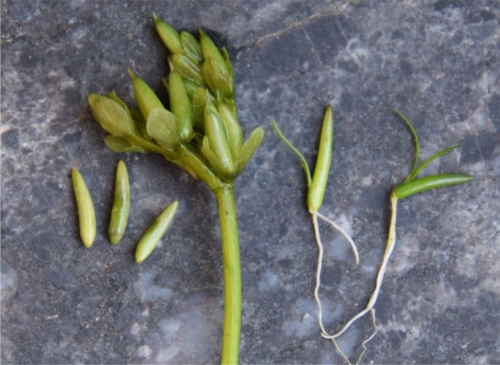
The flowers of this species are unscented, but have been seen to be visited by a fly (Asarkina africana) which settles upon each flower head for several minutes at a time, and consumes its pollen, resulting in cross-pollination.

Uses
Use
Aponogeton angustifolius has no medicinal or magical properties, but it is occasionally cultivated as a seasonal aquatic by specialist growers of water plants.

Growing Aponogeton angustifolius
Grow
This winter-growing species is easily grown in seasonal, shallow, garden ponds up to 500 mm deep, as well as in water-filled shallow bowls, urns and sealed tubs. It requires full sun, or at least morning or afternoon sun from autumn until late spring. Plant the stem tubers in autumn in an upright position, with the tops resting just below ground level, and provide a humus-rich growing medium such as equal parts of well-rotted compost, loam and coarse river sand. Apply an initial heavy water drench in late autumn, and once the leaf tips emerge, gradually submerge the leaves by up to a maximum of 500 mm. Once the leaves begin to turn yellow in late spring, allow the water to evaporate and keep the stem tubers dry during summer.
Propagation is easily achieved by means of spongy, narrow seeds which are released from ripe fruits, and germinate rapidly while floating within water. Harvest germinated seedlings in early spring, once they have formed a couple of leaves and several roots, and pot them up into small containers, submerging them in shallow water. Allow the seedlings to grow until they naturally begin to go dormant, and keep them dry in summer, before planting out the following autumn. The leaves of this species are readily eaten by snails and slugs, and the stem tubers are susceptible to fungal rotting if kept wet during summer.
References
- Glen, R.P. 2000. Aponogetonaceae. In: Leistner, O.A. (ed.), Seed plants of southern Africa: 577–578. Strelitzia 10. National Botanical Institute, Pretoria.
- Kesting, D. & Clarke, H. 2008. Botanical names: what they mean, wild flowers of the Cape Peninsula. Flora Documentation Programme, Friends of Silvermine Nature Area, Muizenberg.
- Du Plessis, E. et al. 1972. Western Cape sandveld flowers. Struik Publishers, Cape Town.
- Mtshali, H., Sieben, E., Day, J.A. & Raimondo, D. 2019. Aponogeton angustifolius Aiton. National Assessment: Red List of South African Plants version 2020.1. Accessed on 2022/07/21.
- Smith, C.A. 1966. Common names of South African plants. Memoirs of the Botanical Survey of South Africa No. 35. Government Printer, Pretoria.
- Van Bruggen, H.W.E. 1985. Monograph of the genus Aponogeton (Aponogetonaceae). Bibliotheca Botanica 137: 1–76.
Credits
Graham Duncan
Kirstenbosch National Botanical Garden
September 2022
Acknowledgements: the author thanks Dr Stuart Hall for the kind use of his photographs, and Dr Annalie Melin for her identification of the fly.
Plant Attributes:
Plant Type: Aquatic, Bulb
SA Distribution: Western Cape
Soil type: Loam
Flowering season: Spring, Winter
PH: Acid, Neutral
Flower colour: White
Aspect: Full Sun, Morning Sun (Semi Shade), Afternoon Sun (Semi Shade)
Gardening skill: Easy
Special Features:
Horticultural zones








Rate this article
Article well written and informative
Rate this plant
Is this an interesting plant?
Login to add your Comment
Back to topNot registered yet? Click here to register.